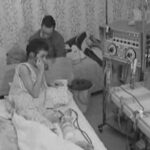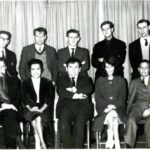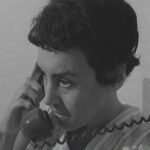
Olga Heppell
Olga Heppell, by Dr Stanley Shaldon‘s right side in the ‘Lucky 13’ photo of the first long-term dialysis patients at the Royal Free Hospital in 1965, was the first home haemodialysis patient in the UK, and one of the first in the world. Home dialysis was commenceded in three units within a few months in 1964 by Drs Merrill in Boston, Scribner in Seattle, and Shaldon in London. More on home haemodialysis.
 In 1964 Olga was unwell and returned to Newcastle, where she had trained as a nurse. She started dialysis there with Dr David Kerr, but needed to return to Essex. The only way to make capacity to treat her was for her to learn how to dialyse herself at home, initially for 15 hours twice weekly. The dialyser for this bold experiment was made by her husband by drilling polypropylene blocks. The pressure alarms on the circuit, from Cambridge Instruments, were a first. These and some switches were fitted into a metal box purchased from Radio Spares on Tottenham Court Road. The large tank for mixing dialysate was made at a local brewery, and all was set up in the living room.
In 1964 Olga was unwell and returned to Newcastle, where she had trained as a nurse. She started dialysis there with Dr David Kerr, but needed to return to Essex. The only way to make capacity to treat her was for her to learn how to dialyse herself at home, initially for 15 hours twice weekly. The dialyser for this bold experiment was made by her husband by drilling polypropylene blocks. The pressure alarms on the circuit, from Cambridge Instruments, were a first. These and some switches were fitted into a metal box purchased from Radio Spares on Tottenham Court Road. The large tank for mixing dialysate was made at a local brewery, and all was set up in the living room.
Dr Rosemarie Baillod was a young doctor who had recently joined the unit unexpectedly (to her), but she remained there for the rest of her professional life. She recalls that on the assigned day in November 1964, she and her colleague Lewis Sevitt were to deliver the artificial kidney, engineered by Mr Heppell, balanced across the back seat of a Mini, to Harlow for the first dialysis. They went the wrong way on the North Circular and arrived late to join Dr Shaldon, a press photographer, and Olga and Ron Heppell. Everything leaked, which Rosemarie had to fix. When all was set up, everyone was pushed outside leaving the Heppells to start – ‘they have to do it by themselves’. And they did.
This was the first unattended overnight dialysis. The Heppells featured in a short 1964 Pathe film of the first home haemodialysis in the UK. As well as (after 8 months experience) in the first episode of the BBC TV programme Tomorrow’s World in 1965.
Harlow is over 30 miles from the Royal Free Hospital, so all management was by telephone, helping the patient and carer to diagnose and manage problems and technical issues with this new machinery. A real understanding, good communication, and trust, were required.
Phone calls
Dr Shaldon was an extraordinary innovator who pushed provision of long term dialysis further and faster than anyone thought possible. But he had a combative manner that must have made him a daunting doctor, and a difficult work colleague. Olga wrote a transcript of calls between her and Dr Baillod in 1965. Dr Shaldon was possibly unaware that Olga could hear his instructions in the background, as well as the translated, gentler delivery by Dr Baillod.
R=Rosemarie Baillod, S=Stanley Shaldon View original transcript.
S: Tell her to keep off that bloody leg or she’ll f—ing well lose that shunt.
R: Stanley says you’re to rest more.
S: Tell her that if that bloody husband of hers doesn’t get his finger out and make that other dialyser, he’ll have a dead wife on his hands.
R: Stanley says when will the new kidney be ready.
S: Tell her that if she doesn’t watch her bloody potassium she’ll be dead of a coronary in a week.
R: Stanley says are you sticking to your diet.
S: Tell her that if she doesn’t pissing well check that water softener properly, I’ll stop home dialysis.
R: Stanley says that the calcium in the last sample was a little high.
S: Tell that if she gets any more infections in that bloody shunt she can go back to Kerr in Newcastle.
R: Stanley says are you washing your hands properly.
S: Tell her to pissing well drive with one hand – both Stirling Moss and I can. (Patient had an arm shunt)
R: He says take care when you are in the car.
S: Tell her that if there are any more bloody cock-ups over the bath sodium, I’ll inform every daily National newspaper in the country that her bloody husband is trying to kill her.
R: Stanley says be careful how you add the concentrate.
S: Ask her what she’s doing with all the bloody Orbenin – washing her hair in it?
R: Stanley says you are using rather a lot of stores.
Further info
Home haemodialysis takes off in 1964 (this site)
Lucky 13 and remarkable long term survivors (historyofnephrology.blogspot.com)
Last Updated on May 29, 2023 by neilturn

